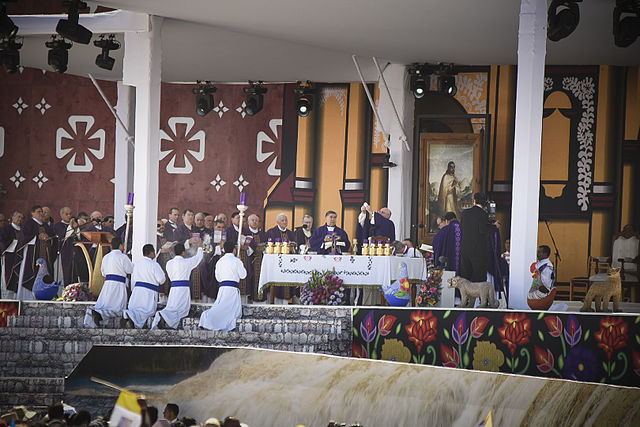IARJ @ Arbeit: Pedro Brieger über den Papst und Lateinamerika

Latin American and Caribbean history since the Spanish conquest has been profoundly impacted by the sword and the cross. The Spanish who descended from ships were usually closely linked to the political power of the ruling elites.
Thus, even in the recurrent Latin American coups of the 20th century, the military that took control did so in the name of Western and Christian civilization.
What changed the scenario was the election of Pope John XXIII in 1958, which inaugurated a new era with the Second Vatican Council of 1962, which had political consequences in the region.
Numerous priests began to rework theology, daily practice, liturgy and – above all things – the relationship between priests and the humble population. It was no coincidence that during the sixties of the last century what was known as Liberation Theology was developed and numerous priests throughout the region decided their option for the poor.
They lived in poor neighborhoods and even worked in factories as simple workers – opposing Western and Christian
dictatorships.
The Liberation Theology priests were also impacted by the Cuban revolution of 1959. Many of them verified that their experience was not contradictory to socialism, despite Marx’s famous phrase of religion as opium of the peoples.
The appointment of Argentine Cardinal Jorge María Bergoglio as Pope Francis in 2013 has an air of continuity with the opening provided by John XXIII. In fact, when Bergoglio was appointed pope he said that the church had to be revitalized. He linked his time to John XXIII’s famous phrase that it was necessary to let fresh air in through the window of the Catholic church.
Of course, the context today is very different from that of sixty years ago. On the one hand, the consolidation of democratic governments in Latin America has allowed a retrospective critical look at the role of the Catholic Church during the military dictatorships, which included the murder of priests and nuns with the complicity of some ecclesiastical hierarchies.
On the other hand, the growth of alternative churches, mainly the numerous evangelical currents that have gained space in the religious and political spheres, has also brought a new air to Latin America. And it’s significant to take into account that Francis succeeded two conservative figures, John Paul II and Benedict XVI, and that for the first time in history there is a Latin American Pope who identifies with the history of the region.
Although Bergoglio was not part of the movement known as Latin American Liberation Theology, it cannot be denied that his current message has many points in common with that movement.
The big difference is that Liberation Theology was persecuted by the powers of the day and the Vatican – and today there are several governments defined as progressive that are in tune with the highest authority of the Vatican.
Francis’ Latin American tours have had a strong political content and are a reflection of the new times. Especially when compared – for example – with the famous visit of John Paul II to Nicaragua in 1983, when he openly questioned the priests who were part of the government Sandinista who had overthrown the Somoza dictatorship in 1979.
In 2016 Pope Francis visited Mexico and did not spare words in criticizing the most powerful sectors. He openly placed himself on the side of the humble. Without euphemisms he criticized businesses’ exploitation of the people and the problem of their insufficient salaries.
In addition to using a language familiar and close to the popular sectors in Mexico, he visited several of the most marginalized areas of the country and the state of Chiapas, where centuries ago Fray Bartolomé de las Casas and Samuel Ruiz were bishops.
In Mexico Francis addressed the indigenous peoples using phrases in their native languages. And he quoted the legendary book, Popol Vuh, which tells the story of the creation of man from the perspective of the indigenous peoples.
It was no coincidence that Indigenous people cheered him, singing “we have a Pope next to the poor” and nicknamed him jTatik
, dad, in the Tzotzil language. It is the same expression that the faithful used in the past for Bishop Samuel Ruiz, who at the time fought the Vatican.
But Francisco today is the Vatican. And he vindicated his figure before thousands of people for the whole world to see, including the ecclesiastical hierarchy, so often criticized for being far removed from the most needy. Every day that passes the figure of Francisco grows larger for the humblest sectors and progressive governments.
In fact, he has become the target of criticism from the most traditional sectors of the Catholic and political establishments, who are more accustomed to conservative popes. Without hesitation, however, Pope Francis has stated that the church must be renewed. In Latin America it already feels as if it has been.
